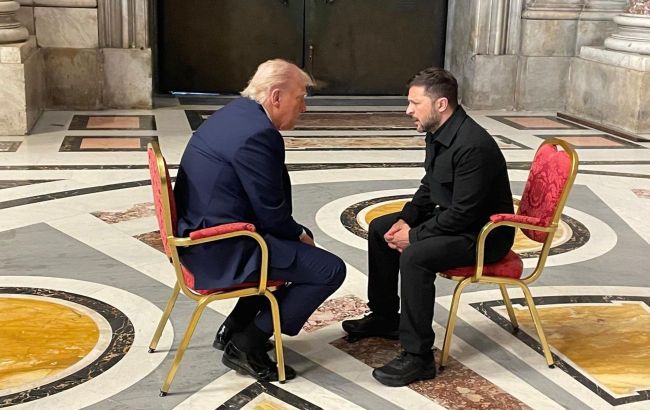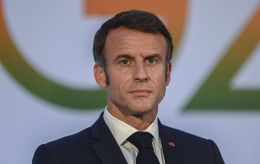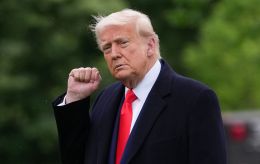Post-Vatican shift: Evolving peace strategies of the US, Ukraine, and Russia
 Donald Trump and Volodymyr Zelenskyy at the Vatican talks (photo: x.com/andrii_sybiha)
Donald Trump and Volodymyr Zelenskyy at the Vatican talks (photo: x.com/andrii_sybiha)
What Ukraine, the US, and Russia are bringing to the new stage of negotiations a week after the meeting in the Vatican and after the signing of the natural resources deal – read on RBC-Ukraine.
Takeaways
- How did the meeting in the Vatican change Trump’s perception of the Russian-Ukrainian war?
- Why did Putin release his minions from the Security Council onto the stage with their nuclear threats?
- How does Ukraine see the further course of the peace negotiations?
The meeting between Volodymyr Zelenskyy and Donald Trump in the Vatican, the photo of which circulated through all global media, indeed became an important event in the permanent peace process. It became noticeable how the American president even changed his public rhetoric on the topic of the Russian-Ukrainian war.
In essence, one could say that the page with the scandal in the Oval Office has now finally been turned. But it does not mean that some kind of qualitative breakthrough in the peace settlement will necessarily happen soon.
Although Washington continues to push all participants in the negotiations and threatens that the US may switch to other international issues if it sees no progress, this week it became increasingly obvious that the United States will not abandon Ukraine.
All the more so as even Vice President JD Vance, one of the most skeptical members of Trump’s team towards Ukraine, publicly reflects on the fact that the US will be “very persistent” in working on the peace settlement over the next 100 days. And he himself admits that “this (war) is not going to end any time soon.”
Although diplomatic activity at various levels will continue in the form of various calls, summits, visits, and negotiations, a sharp change in the situation in the foreseeable future looks unlikely. So, what the US, Russia, and Ukraine are bringing into the new chapter of the negotiations?
US position
“President Trump said in the Oval Office to Zelenskyy, 'You have no cards.' Well, you know what? President Trump just dealt him a royal flush,” commented US Treasury Secretary Scott Bessent on the signing of the minerals agreement.
The signing of the long-awaited document became the main event of the week on the negotiation track, beneficial to both its participants. Ukraine was able to demonstrate that very same “commitment to a peaceful settlement” that the Americans are so persistently demanding from it (while also managing to agree on quite adequate parameters of the agreement). Trump, in turn, was able to show his audience at least some tangible progress on the Russian-Ukrainian track – that same deal-making skill he boasts about, but which has existed mostly in words during his second term.
Meanwhile, phrases in the American president’s rhetoric about “350 billion in Ukrainian debt” and “Ukraine that only asks” have disappeared. Instead, Trump now promises the public multi-billion-dollar profits from the natural resources agreement. Moreover, slowly but surely, for the first time under Trump, there has been activity in selling American weapons to Ukraine – since all current aid was approved during Joe Biden’s term.
The second notable shift in White House rhetoric is growing doubt over whether Putin really wants peace, which is being voiced more and more explicitly. Trump is gradually, very slowly, but still beginning to understand that it is not Ukraine, but Russia is pulling the wool over his eyes.
But the US is still not deviating from the framework set by Trump from the very beginning: the US is not an ally of Ukraine but merely a mediator between the two warring sides. And they fulfill an important – especially in their own view – function, conveying the Russian side’s perspective to Ukraine and Europe, since neither Kyiv, nor Paris, London, or Berlin want to communicate directly with the aggressors.

Meeting of the Ukrainian delegation with Trump's special envoy Keith Kellogg in London (photo: x.com/andrii_sybiha)
One of the documents published by Reuters last week describes a relatively realistic vision of a settlement that the Russians handed over to the Americans. US envoys, in turn, are also persistently trying to determine Ukraine’s red lines. And here, Kyiv's position fully corresponds to the one that the Ukrainian leadership voices publicly.
Although the American leadership has lately shown a better understanding of what is happening in the Russian-Ukrainian confrontation, some illusions still remain. For example, the belief that the aggressors supposedly possess unconditional initiative on the battlefield and that Ukraine faces inevitable defeat if an agreement is not reached here and now – categorically does not correspond to reality.
The main question on the surface is will the US finally dare not just to threaten Russia with sanctions, but to implement these threats? Over the past week, Trump has clearly put away the carrot but still hasn’t brought out the stick.
Russia’s position
Despite the fact that Vladimir Putin and his special envoy Kirill Dmitriev have apparently established good contact with Trump’s special envoy Steve Witkoff, it is quite clear that Moscow is somewhat losing the initiative in the negotiation process. At least, Moscow has not yet achieved anything comparable to the signing of the minerals deal.
The Kremlin apparently understands that the current White House administration gives Russia a unique chance to strike a truly favorable deal, as the next American president may be much less pliable. And even after the 2026 midterm elections to Congress, Trump’s monopoly on power could be shaken.
Therefore, the Russians are now trying their best to project strength to external audiences – primarily to Washington. For this purpose, several interviews with Moscow’s “hawks” from the Security Council have appeared in recent days, threatening the EU and NATO with nuclear strikes, threatening to seize Odesa and carry out the “denazification” of Europe, etc. And this stream of madness has received excellent coverage in leading Western media.
Amid the nuclear hysteria of his minions, Putin got the opportunity to play the role of peacemaker before Trump. Russia decided for the second time recently to bring the idea of a ceasefire on May 9 (and also, apparently, so that foreign guests at events in Moscow would feel more secure).
The aggressors tried to corner Ukraine with a classic trap – the “Have you stopped drinking cognac in the morning?” kind – in which any answer is disadvantageous to the respondent. If Ukraine publicly refused a three-day truce, that would be a great reason to accuse it, in front of Trump, of not wanting peace. If it agreed, it would be playing along with the agenda set by the Russians.
Meanwhile, the assessment given a few weeks ago by RBC-Ukraine's speakers still holds: Moscow currently believes it can significantly strengthen its positions on the front, taking advantage of the favorable summer season. And if the situation is not affected by harsh American sanctions, the aggressors will not agree to a real ceasefire before fall.
Ukraine’s position
Ukraine has outlined several red lines in various negotiations with the Americans. First and foremost, its categorical, absolute disagreement with any formula recognizing Russia’s occupation of Crimea.
The second point – NATO membership cannot be removed from the agenda. Even though there is currently no consensus among NATO member countries on this issue, no third party (in this case, Russia) should have a veto over Ukraine’s foreign policy decisions.
The third key aspect – there can be no talk of easing sanctions. Furthermore, as Foreign Minister Andrii Sybiha stated in the Verkhovna Rada, Ukraine will also not agree to any restrictions on its armed forces or formats of cooperation with Western allies.

A meeting between Volodymyr Zelenskyy and Emmanuel Macron in the Vatican (photo: x.com/andrii_sybiha)
The fact that Ukraine and key European countries (France, the United Kingdom, Germany) act as a united front in contacts with the Americans is also named by RBC-Ukraine's sources as one of the important recent achievements.
Ukraine’s strategic vision for peace negotiations is as follows. First, there must be an unconditional and complete ceasefire for a period of 30 (60, 90) days – Kyiv is not going to play Russian games with a May 9 truce – and confidence-building measures (such as prisoner exchanges on an “all for all” basis), which would then create conditions for further, deeper negotiations.
Including the involvement of Russian representatives – who are essentially not at the negotiating table now. It is important for Ukraine that even at this stage, without the Russians, no fundamental positions are given away.

